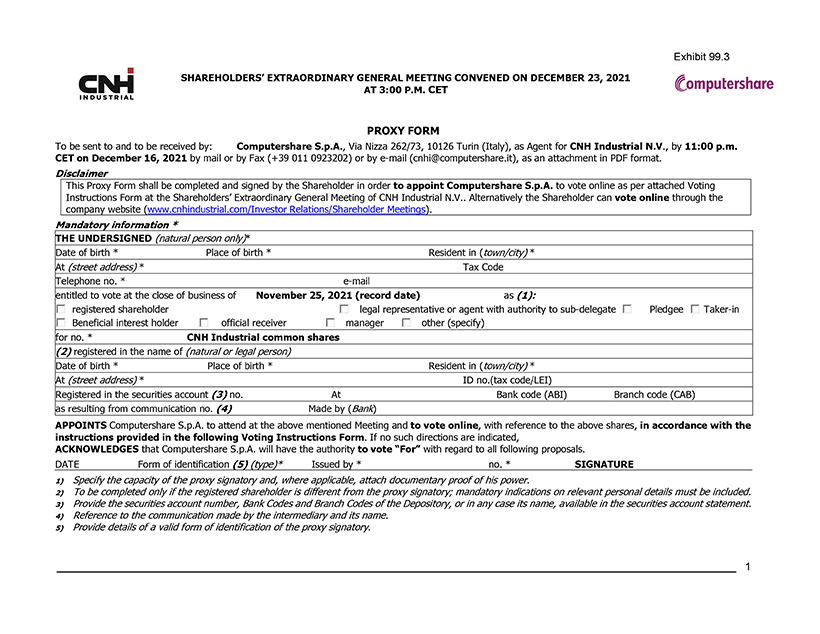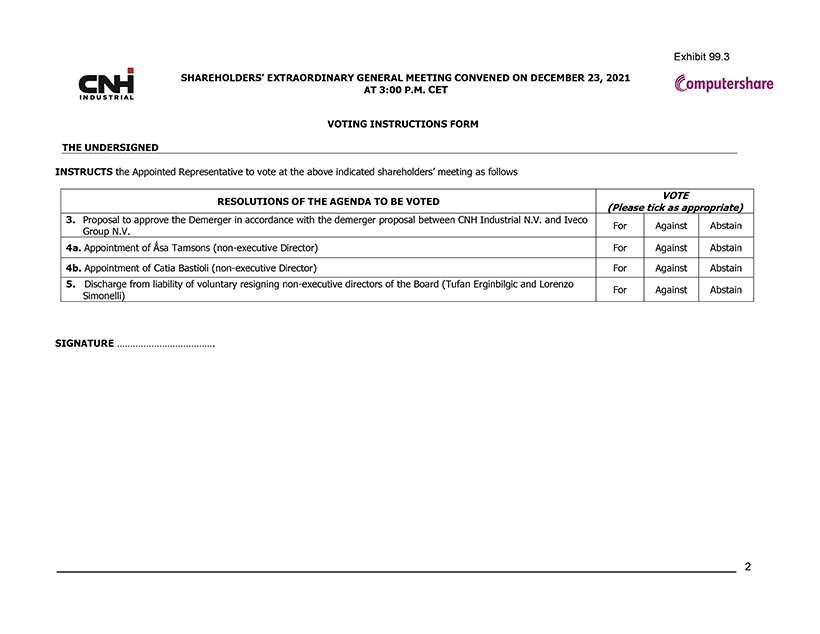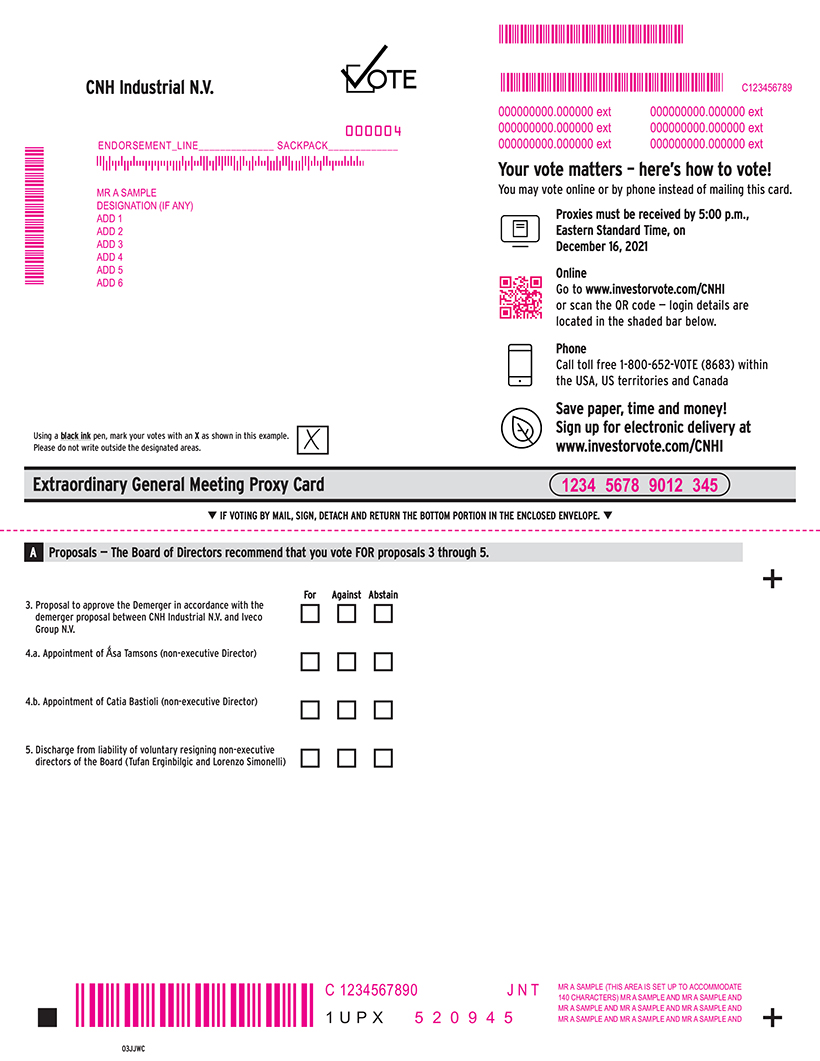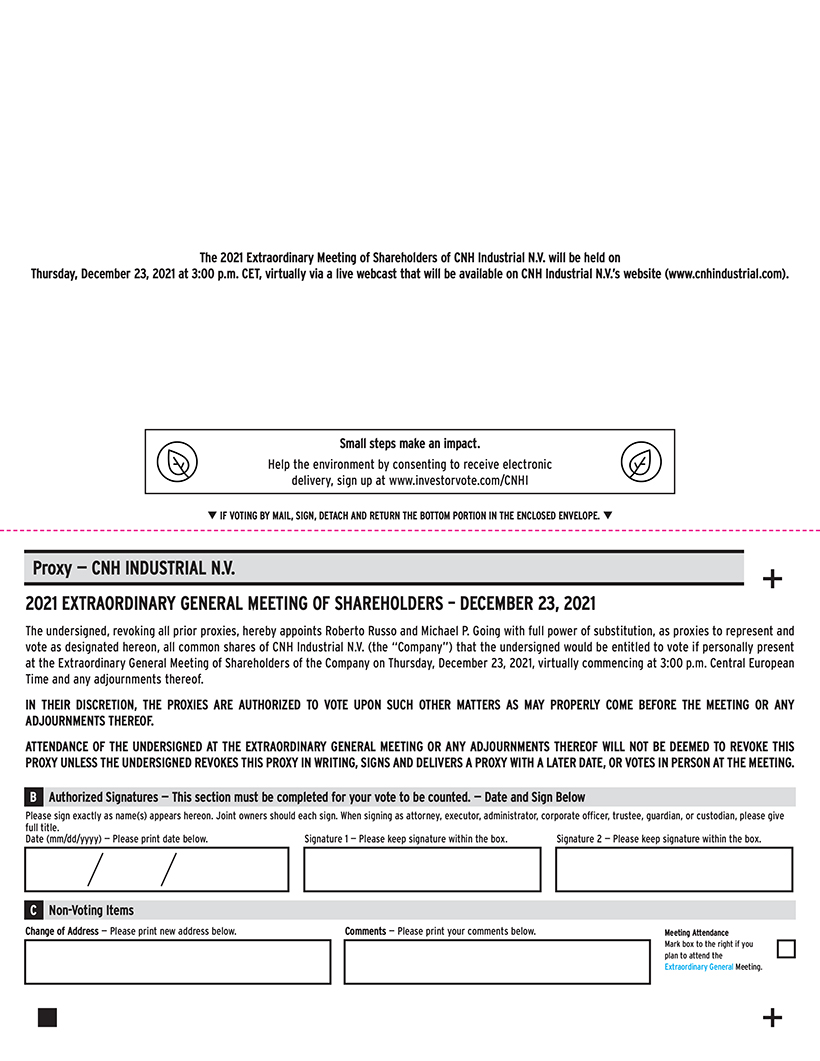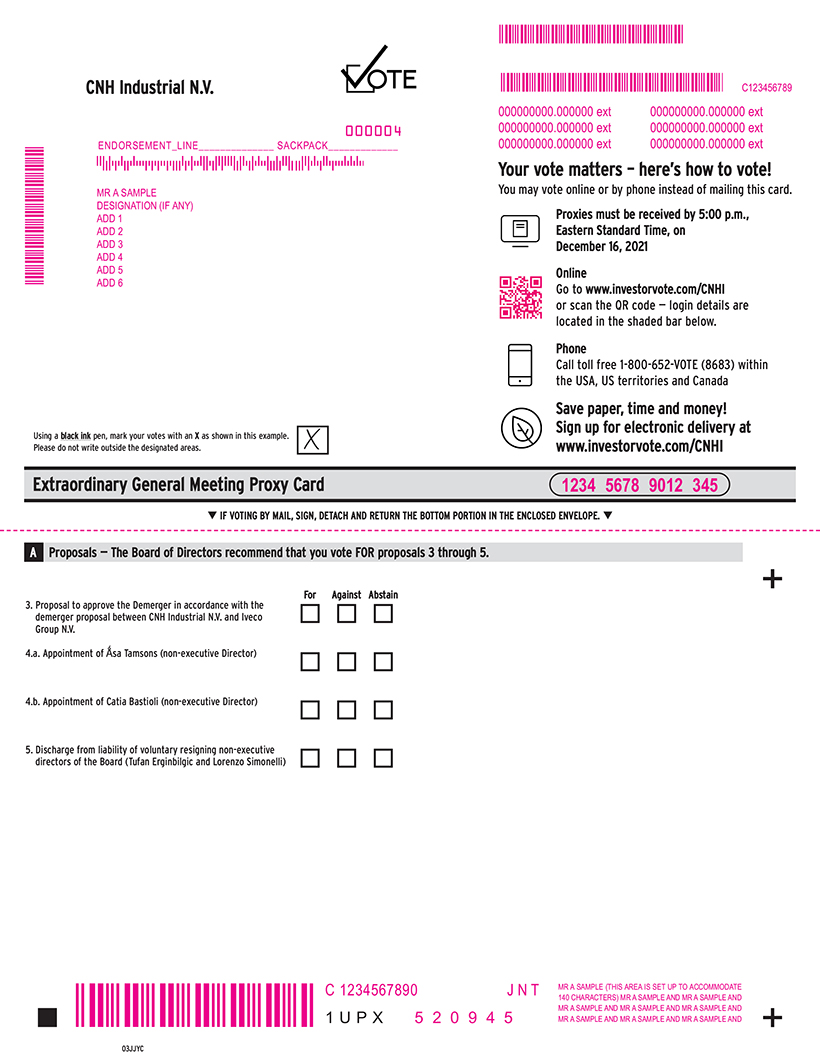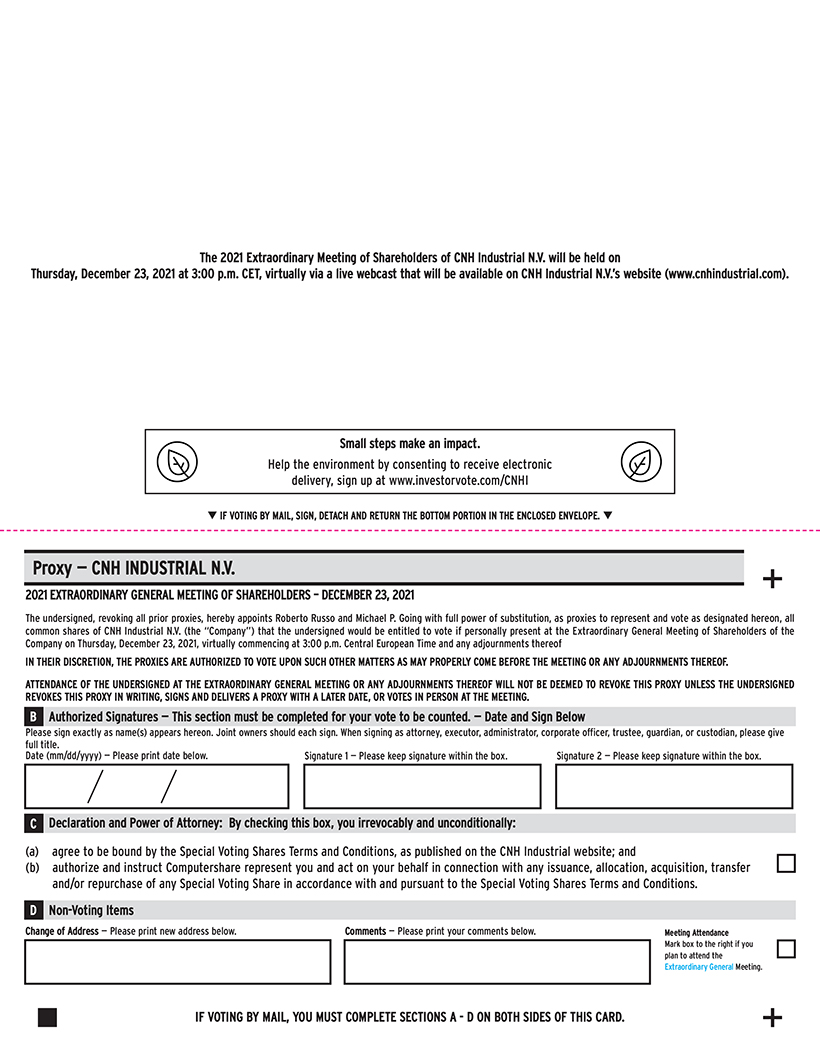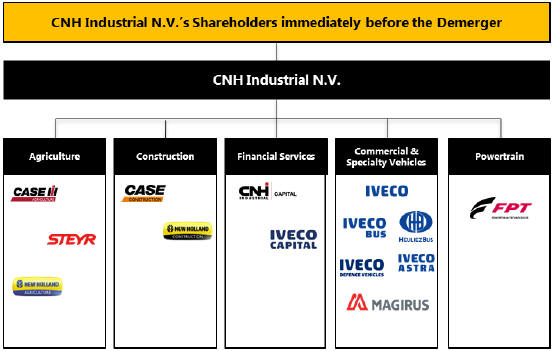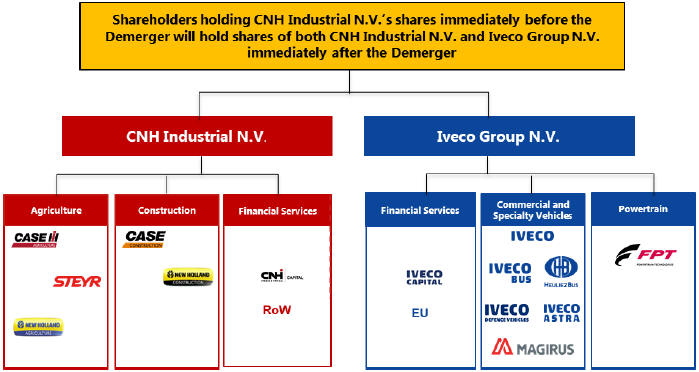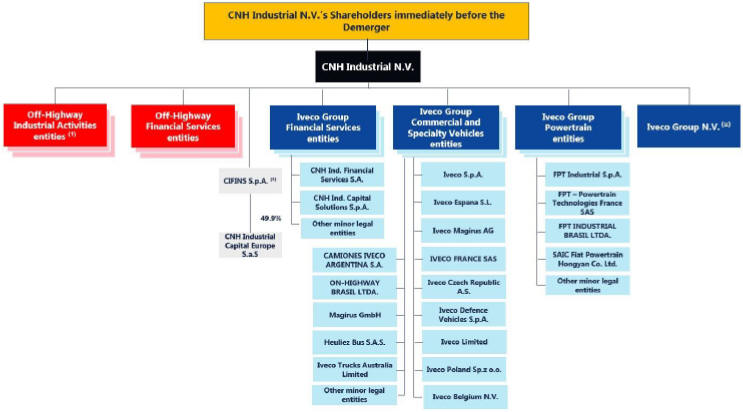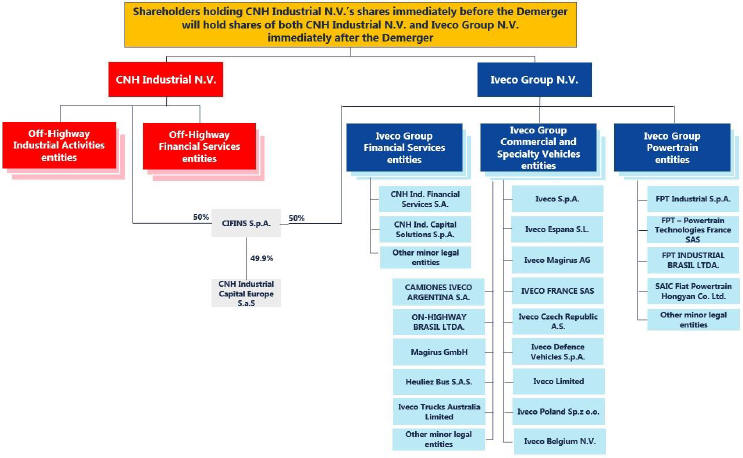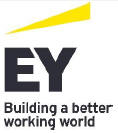
|
Exhibit 99.1 |
NOTICE OF THE EXTRAORDINARY GENERAL MEETING
Notice is hereby given that the Extraordinary General Meeting of Shareholders (the “EGM”) of CNH Industrial N.V. (the “Company” or “CNH Industrial”) will be virtually held at 3.00 p.m. CET on Thursday, December 23, 2021.
To protect the health and safety of all shareholders and participants in connection with the COVID-19 outbreak and considering the temporary legislative measures from the Dutch government, shareholders will not be allowed to attend the EGM in person. The meeting can be followed via a live webcast that will be available on the Company’s website (www.cnhindustrial.com).
Votes can only be cast in advance of the EGM as further set out in this convocation notice. The language of the meeting shall be English. The EGM is convened to discuss and decide on the agenda reflected below.
AGENDA
| 1. | OPENING |
| 2. | EXPLANATION OF THE DEMERGER AS PART OF THE SEPARATION AND LISTING OF THE IVECO GROUP (discussion item) |
| 3. | PROPOSAL TO RESOLVE UPON THE DEMERGER (voting item) |
| 4. | APPOINTMENT OF ÅSA TAMSONS AND CATIA BASTIOLI AS MEMBERS OF THE BOARD OF DIRECTORS (voting item) |
| 5. | DISCHARGE OF VOLUNTARILY RESIGNING MEMBERS OF THE BOARD OF DIRECTORS (voting item) |
| 6. | CLOSE OF MEETING |
EGM documentation
The EGM documentation:
| • | the demerger proposal dated November 11, 2021 between the Company and Iveco Group N.V. and the explanatory notes to the demerger proposal; |
| • | the explanatory notes to the Agenda with the proposed resolution; |
| • | statement of the issued share capital and voting rights at the date of this notice; |
| • | voting instructions and voting proxy forms for the EGM, |
and other relevant EGM documents are available on the Company’s website (www.cnhindustrial.com/Investor Relations/Shareholder Meetings). This documentation is also available at the Company’s principal office at 25 St. James’s Street London, SW1A 1HA (United Kingdom) for shareholders, who will receive a copy free of charge upon request.
The prospectus prepared by Iveco Group NV in relation to the admission is published on the website of Iveco Group N.V. (www.ivecogroup.com) and contains additional information on the demerger. If shareholders wish to further inform themselves on the demerger and its implications, they are recommended to read the prospectus.
Record date
Shareholders can hold Company shares as follows:
| • | shareholders holding special voting shares and common shares or shareholders holding common shares electing to receive special voting shares upon completion of the required holding period (the “Loyalty Shareholders”) registered in the loyalty register of the Company (the “Loyalty Register”). The Loyalty Register is maintained on behalf of the Company in the records of the Company’s agents: Computershare Trust Co. NA and Computershare S.p.A. (each the “Agent” and both, the “Agents”); |
| • | shareholders holding common shares in registered form (the “Registered Shareholders”) in an account at Computershare Trust Co. NA as the transfer agent of the Company (the “Transfer Agent” and together with the Agents, the “EGM Agents”); |
| • | shareholders holding common shares in a bank, brokerage or other intermediary account with the Depository Trust Company (the “DTC Participant Account”); |
| • | shareholders holding common shares in an intermediary account in the Monte Titoli system (the “Monte Titoli Participant Account”). |
Under Dutch law and the Company’s Articles of Association, in order to be entitled to vote in relation to the voting items on the agenda for the EGM, shareholders must (i) be registered as of November 25, 2021 (the “Record Date”*) in the register established for that purpose by the Board of Directors (the “EGM Register”) after reflecting all debit and credit entries as of the Record Date, regardless of whether the shares are still held by such holders at the date of the EGM and (ii) request registration in the manner mentioned below. The EGM Register established by the Board of Directors is: (i) in respect of Loyalty Shareholders, the Loyalty Register, (ii) in respect of Registered Shareholders, the registered shareholder list administrated by the Transfer Agent, and (iii) in respect of shareholders holding common shares in a Monte Titoli Participant Account or in a DTC Participant Account, the list of the entitled shareholders provided by the bank, brokerage or other intermediary (the “Intermediary”)
| * | Because November 25, 2021 is a holiday in the U.S., for U.S. shareholders the effective record date is the close of business on Wednesday, November 24, 2021, the immediately preceding U.S. business day. |
2I1
Voting
Loyalty Shareholders and Registered Shareholders
The EGM Agents will send EGM materials to Loyalty Shareholders and/or Registered Shareholders at the addresses of such shareholders as they appear from the records maintained by the relevant EGM Agent, including a proxy form that allows shareholders to give their voting instructions. The proxy form will also be available on the Company’s website (www.cnhindustrial.com/Investor Relations/Shareholder Meetings), Loyalty Shareholders and/or Registered Shareholders will be entitled to submit their voting instructions or voting proxy (please note proxy instructions below) for the EGM by 11:00 p.m. CET on December 16, 2021 in writing or electronically (contact details at the end of this announcement). They can also cast their vote in advance of the EGM via the web procedure made available on the Company’s website (www.cnhindustrial.com/Investor Relations/Shareholder Meetings).
Shareholders holding common shares in a Monte Titoli Participant Account
Shareholders holding common shares in a Monte Titoli Participant Account who wish to submit voting instructions or a voting proxy (please note proxy instructions below) for the EGM should request that their Intermediary issue a statement (the Notification of Participation) confirming their shareholding (including the shareholder’s name and address and the number of shares notified for attendance and held by the relevant shareholder on the Record Date). Intermediaries must submit the Notification of Participation no later than 11:00 p.m. CET on December 16, 2021 to Computershare S.p.A.
The above-mentioned shareholders may cast their vote in advance of the EGM via the web procedure made available on the Company’s website (www.cnhindustrial.com/Investor Relations/Shareholder Meetings) or by proxy form that will also be available on the Company’s website (please note proxy instructions below).
Shareholders holding common shares in a DTC Participant Account
Shareholders holding common shares in a DTC Participant Account should give instructions to their Intermediary, as the record holder of their shares, who is required to vote their shares according to their instructions. In order to vote their shares, they will need to follow the directions provided by their Intermediary.
Vote by proxy
Subject to compliance with the above provisions, shareholders can also vote for the EGM by proxy and follow the meeting via live webcast on the website of the Company (www.cnhindustrial.com). In order to give voting instructions by proxy, the shareholder (a) must have registered his or her shares as set out above and (b) must ensure that the duly completed and signed proxy including voting instructions, will be received by the relevant EGM Agent (contact details below) by 11:00 p.m. CET on December 16, 2021 in writing or electronically pursuant to instructions contained in the proxy forms. All votes shall be cast electronically or in writing ahead of the EGM in accordance with the proxy and voting instructions.
Questions by Shareholders
Shareholders can submit questions regarding the agenda items of the EGM by email to EGM2021@cnhind.com until December 20, 2021 at 3.00 p.m. CET. The email has to include the name, the surname, the number of shares held by the shareholder, the EGM agenda item to which the question refers and the bank or broker statement proving shareholder’s shareholding at the Record Date. CNH Industrial intends to address the questions during the meeting, to the extent appropriate with a view to the orderly conduct of the meeting. Shareholders who have submitted questions before the deadline mentioned above may ask follow-up questions during the EGM in accordance with the instructions given at the EGM, and only insofar the order of the meeting allows.
Address details of EGM Agents:
Computershare S.p.A.
Via Nizza 262/73, 10126 Torino (Italy)
cnhi@computershare.it or cnhi@pecserviziotitoli.it
Computershare Investor Services
PO BOX 505000
Louisville, KY 40233-5000
Web.queries@computershare.com
By Overnight Delivery:
Computershare
462 South 4th Street
Suite 1600
Louisville, KY 40202
CNH Industrial N.V., November 11, 2021
4I1

